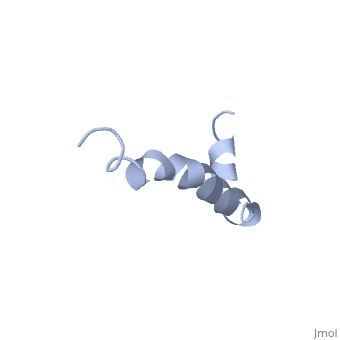Amyloid beta
From Proteopedia
| Line 1: | Line 1: | ||
<StructureSection load=1iyt size='500' side='right' caption='amyloid-beta(1-42)', ([[1dm0]])' scene=''> | <StructureSection load=1iyt size='500' side='right' caption='amyloid-beta(1-42)', ([[1dm0]])' scene=''> | ||
==Introduction== | ==Introduction== | ||
| - | '''Alzheimer's disease''' is characterized by extracellular proteic plaques and intracellular neurofibril tangles.<ref name="structure">PMID: 12423364</ref> These plaques are collections of beta-amyloid <scene name='Amyloid_beta/Fibrils/1'>fibrils</scene> of beta-sheets. The fibrils form when normally soluble amyloid beta proteins reach a critical concentration and become insoluble, misfold, and aggregate.<ref name="stuff">PMID:22108203</ref> When amyloid beta comes into contact with metal ions and oxygen the result is the production of reactive oxygen species (especially hydrogen peroxide) without oxygen and metal ions amyloid beta ca induce pore formation in neuronal and endothelial cells, triggering cell death.<ref name="structure" /><ref name="alz" /> Yet another source of amyloid beta toxicity stems from its ability to induce endothelial cell damage through the production of superoxide, though the mechanism of such induction is unclear.<ref name="alz" /> While the presence of the fibril plaques remains a marker for Alzheimer's disease recent studies have suggested that alymoild beta oligomers most devestating effect is the impairment of long-term potentiation which decreases dendritic spine density in the hippocampal brain and impairs memory.<ref name="recent">PMID:22114742</ref> | + | '''Alzheimer's disease''' is characterized by extracellular proteic plaques and intracellular neurofibril tangles.<ref name="structure">PMID: 12423364</ref> These plaques are collections of beta-amyloid <scene name='Amyloid_beta/Fibrils/1'>fibrils</scene> of beta-sheets. The fibrils form when normally soluble amyloid beta proteins reach a critical concentration and become insoluble, misfold, and aggregate.<ref name="stuff">PMID:22108203</ref> When amyloid beta comes into contact with metal ions and oxygen the result is the production of reactive oxygen species (especially hydrogen peroxide) without oxygen and metal ions amyloid beta ca induce pore formation in neuronal and endothelial cells, triggering cell death.<ref name="structure" /><ref name="alz">PMID:18305836</ref> Yet another source of amyloid beta toxicity stems from its ability to induce endothelial cell damage through the production of superoxide, though the mechanism of such induction is unclear.<ref name="alz" /> While the presence of the fibril plaques remains a marker for Alzheimer's disease recent studies have suggested that alymoild beta oligomers most devestating effect is the impairment of long-term potentiation which decreases dendritic spine density in the hippocampal brain and impairs memory.<ref name="recent">PMID:22114742</ref> |
==Structure== | ==Structure== | ||
Revision as of 19:26, 29 November 2011
| |||||||||||
Neurotoxicity
Generation of Radicals Amyloid beta produces reactive oxygen species, which induces oxidative stress and inflammation.[3]
Pore Formation Amyloid beta can adhere to endothelial cell walls and create lesions, eventually a large deposite will cause cerrbral hemorrhage. The pores cause loss of calcium homeostasis and an influx of Ca2+ into neurons.[3]
Interaction with tau Tau proteins function to stabilize microtubules [[1]]. Association between Tau proteins and amyloid beta results in dissociation of tau from microtubules which collapses the axonal structure leading to the death of neurons.[3]
Binding ApoE Apolipoprotein E is normally involved in lipoprotein metabolism and transfer but it has been shown to play a role in the development of Alzheimers. ApoE4 has the most affinity for amyloid beta and uses the low-density lipoprotein-related protein receptor to internalize amyloid beta into neurons it also promotes the production od amyloid beta by stimulating APP recycling. It is also theorized that apolipoproteins promote the aggregation of amyloid beta into toxic oligomers.[3]
Binding ABAD
Binding Catalase
Prevention
The most promising prevention of amyloid beta has been to prevent the enzymes responsible for its creation. AF267B which is a muscarine receptor that activates aplha-secretase and reduces tau pathology.[3] Thus far no true treatment or prevention has been determined for Alzheimer's.
References
- ↑ 1.0 1.1 1.2 1.3 Crescenzi O, Tomaselli S, Guerrini R, Salvadori S, D'Ursi AM, Temussi PA, Picone D. Solution structure of the Alzheimer amyloid beta-peptide (1-42) in an apolar microenvironment. Similarity with a virus fusion domain. Eur J Biochem. 2002 Nov;269(22):5642-8. PMID:12423364
- ↑ Vlassenko AG, Benzinger TL, Morris JC. PET amyloid-beta imaging in preclinical Alzheimer's disease. Biochim Biophys Acta. 2011 Nov 12. PMID:22108203 doi:10.1016/j.bbadis.2011.11.005
- ↑ 3.0 3.1 3.2 3.3 3.4 3.5 3.6 3.7 3.8 3.9 Rauk A. Why is the amyloid beta peptide of Alzheimer's disease neurotoxic? Dalton Trans. 2008 Mar 14;(10):1273-82. Epub 2008 Feb 12. PMID:18305836 doi:10.1039/b718601k
- ↑ Funke SA. Detection of Soluble Amyloid-beta Oligomers and Insoluble High-Molecular-Weight Particles in CSF: Development of Methods with Potential for Diagnosis and Therapy Monitoring of Alzheimer's Disease. Int J Alzheimers Dis. 2011;2011:151645. Epub 2011 Nov 2. PMID:22114742 doi:10.4061/2011/151645

